CSIR NET CHEMISTRY (June - 2019)
Previous Year Question Paper with Solution.
21.The role of H3PO4 in the examination of Fe(II) with K2Cr2O7 using diphenylamine sulphonate as indicator is to
(a) Avoid aerial oxidation of Fe(II)
(b) Reduce the electrode potential of Fe3+  Fe2+
Fe2+
(c) Stabilize the indicator
(d) Stabilize K2Cr2O7
Ans.b
Sol.H3PO4 is used in the estimation of Fe(II) with K2Cr2O7 using diphenylamine sulphonate as indicator to reduce the electrode potential for the Fe3+  Fe2+ reaction by stabilising the ferric ion.
Fe2+ reaction by stabilising the ferric ion.
Correct option is (b)
22. is
is
(a) Having a shorter O–O bond length than that in O2
(b) A stronger oxidising agent than O2
(c) IR active
(d) Unable to abstract proton from weak acids
Ans.b
Sol.
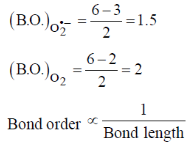
Bond order of O2 is more than  thus, bond length of
thus, bond length of  is more thant O2.
is more thant O2.
• The superoxide ion  is able to abstract proton from weak acids. It reacts with a proton or proton donor to form
is able to abstract proton from weak acids. It reacts with a proton or proton donor to form 

• The superoxide ion  is a stronger oxidising agaent than O2.
is a stronger oxidising agaent than O2.
•  does not possess dipole moment thus, it is IR inactive.
does not possess dipole moment thus, it is IR inactive.
Correct answer is (b)
23.In neutron activation analysis the radiation commonly detected is
(a) 
(b) 
(c) 
(d) X-rays
Ans.c
Sol.In neutron activation analysis, the specimen is placed into a suitable irradiation facility and bombarded with neutrons. This creates artificial radio isotopes of the elements present. Following irradiation, the artificial radioisotopes decay with emission of particles or, more importantly gammarays, which are characteristic of the elements from which they were emitted.
Correct option is (c)
24.The metal transferred by bacteria and fungi using siderophores / siderochromes is
(a) Mo
(b) Cu
(c) Fe
(d) Zn
Ans.c
Sol.Siderophores / sideerochromes are small, high-affinity iron-chelating compounds secreted by microorganisms such as bacteria and fungi and serving to transport iron across all membranes.
Correct option is (c)
25.Self – exchange electron transfer is fastest in
(a) [Ru (NH3)6]2+/3+
(b) [Co (NH3)6]2+/3+
(c) [Cr (OH2)6]2+/3+
(d) [Fe (OH2)6]2+/3+
Ans.a
Sol.Electron transfer reactions by self-exchange electron transfer is fast when HOMO is  and LUMO is also
and LUMO is also  i.e. electron transfer is from
i.e. electron transfer is from  of reductant to the
of reductant to the  of oxidant.
of oxidant.




Both reactions (a) and (d) are fast but reaction (a) is much faster than (d) because there is small change in M-L bond length in reaction (a) i.e. less activation energy is required.
Correct option is (a)
26.The number of Ni-Ni bonds in  complex obeying the 18 electron rule is
complex obeying the 18 electron rule is
(a) 0
(b) 1
(c) 2
(d) 3
Ans.a
Sol.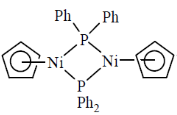

Therefore, No M–M bonds
Correct option is (a)
27.For the reaction of trans - [IrX (CO) (PPh3)2] (X = F, Cl, Br, I) with O2, correct order of variation of rate with X is
(a) Br > I > F > Cl
(b) F > Cl > Br > I
(c) 
(d) I > Br > Cl > F
Ans.d
Sol.
Electron withdrawing group present on the metal decreases the electron density and hence decreases the rate of oxidative addition because the rate of oxidative addition is directly proportional to the electron density on the metal.

Correct answer is (d)
28.The species that results by replacing one quarter of Si(IV) in pyrophyllite [Al2 (OH)2Si4O10] with Al(III) [charge balance by K(I)] is
(a) Muscovite
(b) Phlogopite
(c) Montmorillonite
(d) Talc
Ans.a
Sol.
29.The reaction of  with I– in aqueous acidic medium results in
with I– in aqueous acidic medium results in
(a) I2 and H2O
(b) I2 and H2O2
(c) IO– and H2O
(d) IO– and H2O2
Ans.a
Sol.
30.The organic species isolobal to [Fe(CO)2 (PPh3)]– is
(a) 
(b) CH–
(c) CH3
(d) CH
Ans.d
Sol.
For d9-ML3, original co-ordination number will be considered as ML6.
Therefore [Fe(CO)2(PPh3)]–having three co-ordination number, missing three from original ML6 and similarly for CH, three ligands also missing from original CH4.
Hence, [Fe(CO)2(PPh3)]–is isolobal with CH but not with  because two ligands missing from original CH4.
because two ligands missing from original CH4.
Correct option is (d)
31.The oxidation state of sulphur in the dithionous and dithionic acids, respectively, are
(a) +4, +6
(b) +4, +5
(c) +3, +5
(d) +3, +6
Ans.c
Sol.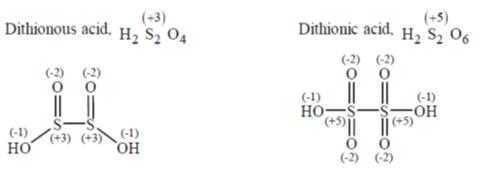
Correct answer is (c)
32.Consider the following reaction :

The stability constants for [HgX]+ (aq) for X = F, Cl and Br follow the order
(a) F < Cl < Br
(b) Br < Cl < F
(c) Cl < Br < F
(d) Br < F < Cl
Ans.a
Sol.
The stability constants for [HgX] +(aq) for X = F, Cl, Br follow the order : F < Cl < Br
Because Hg2+ is soft acid and Br– is soft base.
Correct option is (a)
33. The coordination number of Gd in GdCl3.6H2O is
(a) 3
(b) 6
(c) 8
(d) 9
Ans.c
Sol.In hexahydrate of gadolinium (III) chloride, six H2O molecules and 2Cl– ions coordinate to the metal cation resulting in a coordination number of 8.

34.Among the following, the correct statement abount  orbitals
orbitals  of benzene is
of benzene is
(a) Only the lowest energy MO is doubly degenerate
(b) Only LUMO is doubly degenerate
(c) Only HOMO is doubly degenerate
(d) Both the HOMO nad LUMO are doubly degenerate.
Ans.d
Sol.The MO diagram of benzene is

Thus both HOMO and LUMO are double degenerate.
Correct option is (d)
35.The major product(s) formed in the following reaction is (are)

(a) 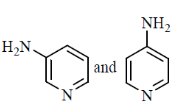
(b) 
(c) 
(d) 
Ans.a
Sol.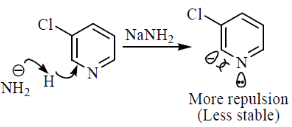
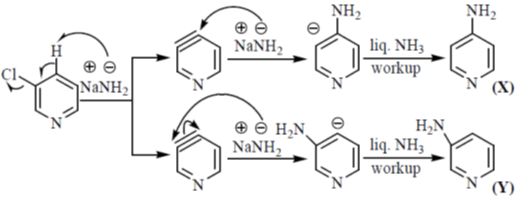
Products (X) and (Y) formed in 2 : 1 ratio respectively.
Correct option is (a)
36.The number of 1H NMR signals observed for the following compound is
(a) 3
(b) 4
(c) 5
(d) 6
Ans.b
Sol.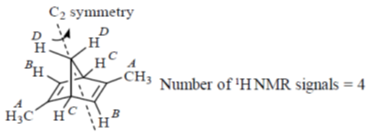
Correct answer is (b)
37.The correct order of reactivity of the following dienes towards reaction with maleic anhydride is
(a) E-1-chlorobuta-1, 3-diene < E-penta-1, 3-diene < E-1-methoxybuta-1, 3-diene
(b) E-penta-1, 3-diene < E-1-chlorobuta-1, 3-diene < E-1-methoxybuta-1, 3-diene
(c) E-1-methoxybuta-1, 3-diene < E-1-chlorobuta-1, 3-diene < E-penta-1, 3-diene
(d) E-1-methoxybuta-1, 3-diene < E-penta-1, 3-diene < E-1-chlorobuta-1, 3-diene
Ans.a
Sol.In Diels-Alder reaction, electron rich diene has more reactivity towards Dienophile.

38.In the following equilibrium, conformer B is more stable than A when R is

(a) Me
(b) F
(c) Cl
(d) OMe
Ans.b
Sol.
Energy of  and
and  lies comparatively lower in energy than Cl, OMe, Me. So, better interaction occurs in (C – H) with (C – F).
lies comparatively lower in energy than Cl, OMe, Me. So, better interaction occurs in (C – H) with (C – F).
Correct option is (b)
39. The major product formed in the following reaction is
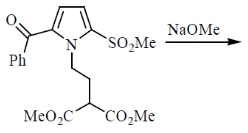
(a) 
(b) 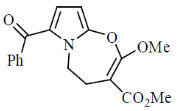
(c) 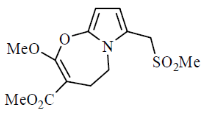
(d) 
Ans.a
Sol.
Correct answer is (a)
40.The major product formed in the following reaction is

(a) 
(b) 
(c) 
(d) 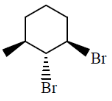
Ans.c
Sol.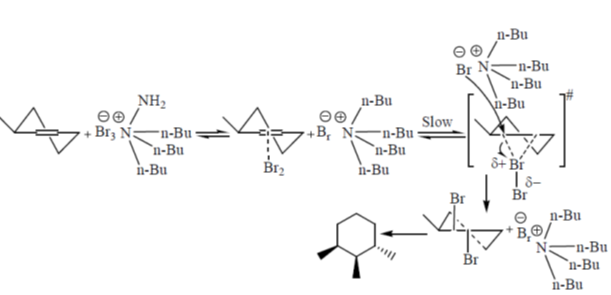
Correct answer is (c)
41.The relationship between A and B is
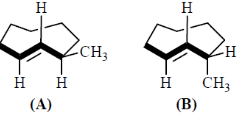
(a) Homomers (identical)
(b) Enantiomers
(c) Diastereomers
(d) Conformers
Ans.c
Sol.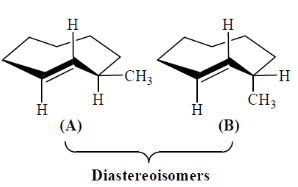
Correct answer is (c)
42.The most stable conformation of the following molecule is

(a) 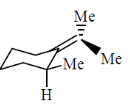
(b) 
(c) 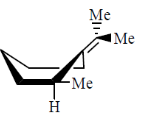
(d) 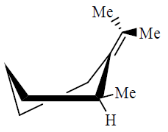
Ans.b
Sol.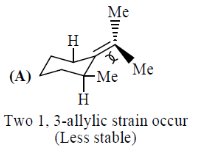
Energy
= 1, 3-CH3 / H allylic interaction = 1.3 kcal / mole
= 1, 3-CH3 / CH3 allylic interaction = 7.6 kcal / mole
= Total Energy = 8.9 kcal / mole
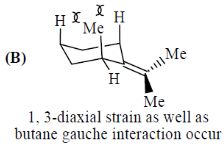
Energy
= 1, 3-CH3 / H axial interaction = 0.9 kcal / mole
= 0.9 × 2 = 1.8 kcal / mole
Most preferred conformation
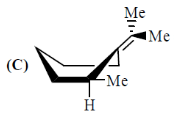
Boat form is least stable due to angular strain as well as four pair of elipsing effect
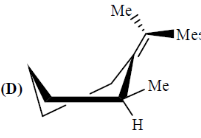
Twist boat is less stable due to angular strain.
In the above conformation 1, 3-allylic strain, eclipsing effect and angular strain are dominant over 1, 3-diaxial interaction. So, most stable conformation is (B)
Correct answer is (b)
43.Reaction of deoxymonosaccharide A with 2 equivalents of HIO4 affords propanedial, formic acid and formaldehyde. The structure of A is
(a) 
(b) 
(c) 
(d) 
Ans.a
Sol.

Correct answer is (a)
44.The major product formed in the following reaction is

(a) 
(b) 
(c) 
(d) 
Ans.b
Sol.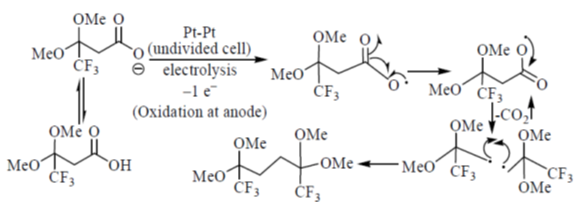
Correct answer is (b)
45.The compound that will show a base peak at m / z 120 in its E1 mass spectrum is
(a) 
(b) 
(c) 
(d) 
Ans.c
Sol.All are isomeric compounds, molecular weight is 152
Molecular ions peak will be at m/z = 152
Peak at m / z 120 will be due to 152 - 120 = 32 mass loss = CH3OH loss
Meta and para iosmers can not give CH3OH loss
Correct answer is (c)
46.The major product formed in the following reaction is

(a) 
(b) 
(c) 
(d) 
Ans.c
Sol.
Correct answer is (c)
47.The mobility of a divalent cation in water is 8 × 10–8 m2 V–1 s–1. The effective radius of the ion is (viscosity of wate = 1 cP; e = 1.6 × 10-19 C)
(a) 106 pm
(b) 212 pm
(c) 424 pm
(d) 318 pm
Ans.b
Sol.
Correct answer is (b)
48.The electrical double layer model among the following that consists of both fixed and diffuse layers is
(a) Helmoltz
(b) Gouy
(c) Stern
(d) Debye-Huckel
Ans.c
Sol.Stern Model consists of both fixed and diffuse layers
Correct answer is (c)
49.The lowest energy unnormalized wave function of  molecule is (r1 and r2 are the distances between the elctron and nuclei 1 and 2, respectively)
molecule is (r1 and r2 are the distances between the elctron and nuclei 1 and 2, respectively)
(a) 
(b) 
(c) 
(d) 
Ans.a
Sol. molecule consists of an electron orbiting about two protons (two nucleus). Here, we can assume the protons as stationary objects because the electron moves far more rapidly than protons.
molecule consists of an electron orbiting about two protons (two nucleus). Here, we can assume the protons as stationary objects because the electron moves far more rapidly than protons.
The unnormalized ground-state wave function of the molecule can be formed by the linear combination of hydrogen ground state wave functions centered on each proton (nucleus). Therefore, the unnormalized wavefunction of the  molecule can be written as
molecule can be written as

where, r1 and r2 are the distances between the electron and nulcei 1 and 2, respectively.

Since, number of nodes in  is greater than the number of nodes in
is greater than the number of nodes in  therefore
therefore 
 will corresponds to the ground state wavefunction of
will corresponds to the ground state wavefunction of  molecule.
molecule.
Correct answer is (a)
50.Nearest neighbour distance in a crystal system of side length a is 
(a) Face-centered cube
(b) Body-centered cube
(c) Trigonal primitive
(d) Primitive cube
Ans.a
Sol.In face central cubic crystal system we observed nearest neighour distance = d
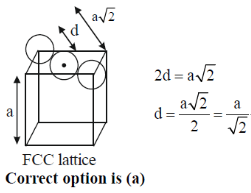
51.for a particle of mass m in a one-dimensional box of length 2L, the energy of the level corresponding to n = 8 is
(a) 
(b) 
(c) 
(d) 
Ans.d
Sol.The energy eigenvalues of the particle moving in a one-dimensional box of length 2L, is

The energy of the level corresponding to n = 8 is

52.The correct statement about HCl and DCl, among the following, is
(a) DCl has a smaller zero-point energy than HCl
(b) HCl has a smaller vibration frequency than DCl
(c) The force constant k of the HCl bond is half that of DCl
(d) The reduced mass of DCl is smaller than that of HCl
Ans.a
Sol.Reduced mass is given 

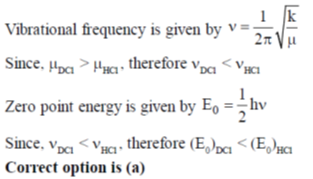
53.One mole of a mono-atomic ideal gas is transformed from 300K and 2 atm to 600K and 4 atm.
The entropy change for this process is
(a) 
(b) 
(c) 
(d) 
Ans.a
Sol.
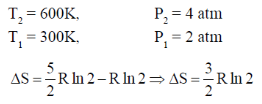
Correct answer is (a)
54.The allowed transition in an atomic system is
(a) 
(b) 
(c) 
(d) 
Ans.a
Sol.Selection rule for atomic transition :



Correct answer is (a)
55.The total number of symmetry elements in diborane molecule is
(a) 2
(b) 4
(c) 6
(d) 8
Ans.d
Sol.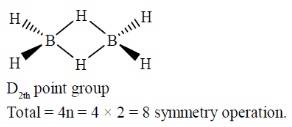
Correct answer is (d)
56.A physical observable, 'x', appears with the probability distribution e(–|2x–12|). The average of 'x' would be
(a) 0
(b) 3
(c) 6
(d) 12
Ans.c
Sol.Given probability distribution :

Since the probability distribution is symmetric about x =6, therefore the average value of the physical observable 'x' will be equal to 6.
Correct answer is (c)
57.The rotational partition function is expected to be the smallest for the molecule, among the following
(a) H2
(b) Li2
(c) N2
(d) F2
Ans.a
Sol.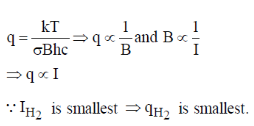
Correct answer is (a)
58.If the half-life of a reaction is inversely proportional to the square of the concentration of the reactant, the order of the reaction is
(a) 0
(b) 1
(c) 2
(d) 3
Ans.d
Sol.
Correct answer is (d)
59.The degree of a polymeristion  and the fraction of monomer consumed (P) for a polymerization reaction are related as
and the fraction of monomer consumed (P) for a polymerization reaction are related as
(a) 
(b) 
(c) 
(d) 
Ans.a
Sol.For a polymer of type A – B – A – B – A – B – ........ – A – B,
Let 'P' be the probability that group B combines with group A. For 'k' units in the polymer, there are (k–1) linkages between A and B. So, its probability is pk-1.
Probability that group B is not combined with group A be '1-p'
So, for the molecule to terminate after (k – 1) linkages, the probability is pk-1 (1–p).
Similarly, probability that the chain has 'k' units is
 Number of chains having 'k' units
Number of chains having 'k' units
and N : Total number of chains.



60.The correct match for the compounds in Column-I with the property in Column-II is
Column - IColumn – II
(P)Dichlorodifluoromethane(I)Anti - inflammatory
(Q)Sulfadiazine(II)Insecticidal
(R) Cortisone(III) Antibacterial
(S) Hexachlorobenzene(IV) Ozone layer depletion
(a) P-II, Q-I, R-IV, S-III
(b) P-IV, Q-I, R-II, S-III
(c) P-I, Q-III, R-II, S-IV
(d) P-IV, Q-III, R-I, S-II
Ans.d
Sol.(P) Dichlorodifluoro methane  (iv) Ozone layer depletion
(iv) Ozone layer depletion
(Q)Sulfadiazine  (iii) Antibacterial
(iii) Antibacterial
(R)Cortisone  (i) Anti-inflammatery
(i) Anti-inflammatery
(S) Hexachlorobenzene  (ii) Insecticidal
(ii) Insecticidal
Correct option is (d)
61.The correct statements about [Ru6C(CO)17] cluster from the following
(1)it is an 86 electron cluster
(2)it is a closo structure type
(3)its shape is capped square pyramid
(4) carbon interacts with all the Ru centres in the cluster are
(a) 1, 2, 3 and 4
(b) 1 and 2 only
(c) 1, 2, and 3
(d) 1, 2, and 4
Ans.d
Sol.[Ru6C(CO)17]
TEC = 8 × 6 + 4 + 17 × 2 = 86
PEC = TEC – n × 12
PEC = 86 – 6 × 12
PEC = 86 – 72 = 14
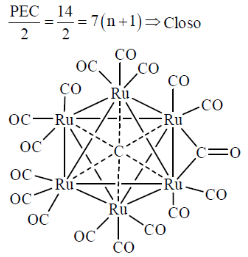
In the cluster [Ru6C(CO)17], the carbon atom is encapsulated at cavity of cluster and equally interacted with all Ru centres.
Correct option is (d)
62.A plausible structure of the intermediate involved in the following reaction

(a) 
(b) 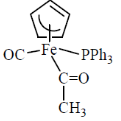
(c) 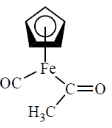
(d) 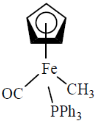
Ans.c
Sol.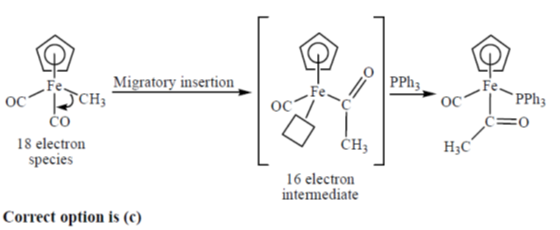
63.In the synthesis of polydimethylsiloxane, the chain forming, branching and terminating agents respectively, are
(a) Me2SiCl2, Me3SiCl and MeSiCl3
(b) Me2SiCl2, MeSiCl3 and Me3SiCl
(c) MeSiCl3, Me2SiCl2 and Me3SiCl
(d) Me2SiCl2, MeSiCl3 and Me4Si
Ans.c
Sol.Poly dimethyl siloxane (PDMS) is :
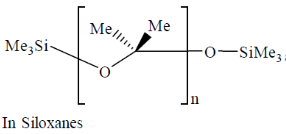
Me3SiCl : used as terminating agents 
Me2SiCl2 : used as chain forming 
MeSiCl3 : used as cross linkers for branching

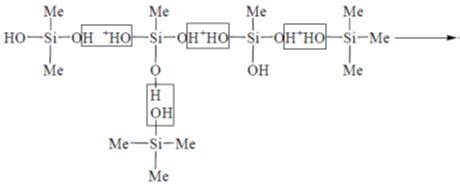
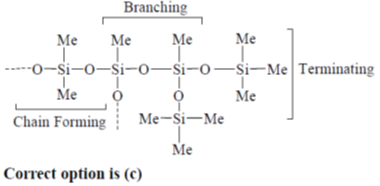
64.The set among the following in which all numbers are magic numbers of nucleons is
(a) 20, 28, 50 and 126
(b) 24, 28, 82 and 126
(c) 20, 50, 80 and 184
(d) 28, 50, 82 and 180
Ans.a
Sol.The magic numbers of nucleons 2, 8 , 20, 28, 50, 82, 126.
Correct option is (a)
65. Incorrect statement for amperometric titration is
(a) It is based on measurement of diffusion current
(b) Its sensitivity is always higher than those of spectrophotometric titrations
(c) It does not generally require an indicator
(d) It requires inert atmosphere (N2 / Ar)
Ans.d
Sol.• Copper (Cu), Silver (Ag) and Gold (Au) are called currency metal (present in native form). Amperometric titration is the one of the economic technique for estimation of these metals.
• It is a class of titration in which the equivalence point is determine through measurement of electric current produced by the titration reaction.
• Amperometric titration sensitivity is always higher than those of spectrophotometeric titrations.
• Amperometric titration does not generally require an indicator
• Amperometric titration does not require inert atmosphere.
Correct option is (d)
66.Consider the following statements with respect to Cytochrome P-450
(A)It has histidine coordinated to iron centre
(B)It is a membrane bound metalloenzyme
(C) It has Fe(III) ion in the resting state of the enzyme
The correct statemen(s) is / are
(a) A, B
(b) A, C
(c) B, C
(d) A only
Ans.c
Sol.Cytochrome P-450 is a membrane bound metalloenzyme. The function of most cytochrome P-450 enzyme is to catalyze the oxidation of organic substrate. In the active site of cytochrome P-450, iron is in + 3 oxidation state and it is in octahedral geometry whereas the basal plane is composed of four N atoms the porphyrin ring, fifth position is occupied by a cysteine moiety and sixth position is occupied by H2O molecule.
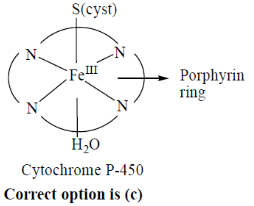
67.Consider the following transformation reactions in the context of co-enzyme B12
(A)1, 2-Carbon shift(b)Hydration of CO2
(c)Benzene to phenol(d)Dimethyl sulfide to dimethyl sulfoxide
The correct statement(s) for co-enzyme B12 is / are
(a) A, C, D
(b) A, B only
(c) B, C only
(d) A only
Ans.d
Sol.• Coenzyme Vit-B12 was the first organometallic compound discovered in living systems. This coenzyme catalyses 1,2 – rearrangement

• Coenzyme B12 readily accepts a methyl group or hydroxyl methyl group (bound to Co) that can be transferred to add a carbon to a substrate.

• Coenzyme B12 reduces – CH(OH) group to –CH2 group
Correct option is (d)
68.The correct statements regarding B among the following
(I)Nuclear spin of 11B is greater than that of 10B
(II)The polarities of B–H bond and C–H bonds are opposite
(III) Cross-section of neutron absorption for 10B is much more than that of 11B
(IV) B reacts with boiling aq. NaOH solution to form NaB(OH)4 are
(a) II and III
(b) I and II
(c) III and IV
(d) II and IV
Ans.a
Sol.
This indicates that polarities of B – H and C – H bonds are opposite
• Thermal neutron absorption cross section for 10B = 3837 Barn and for 11B = 0.005 Barn
• Boron resists attack byboiling conc. aqueous NaOH or fused NaOH upto 500ºC.

Boron react with fused alkali to give sodium metaborate and H2.
Correct option is (a)
69.Choose the correct statement(s) among the following
(I)LiF is more soluble than LiClO4 in water.
(II)The standard reduction potential [Eo] of Li is more negative than that of Na.
(III) The heat of hydration of Li+(g) is greater than that of Na+(g)
(a) I and II
(b) I and II
(c) III and IV
(d) III only
Ans.c
Sol.• LiF is sparingly soluble in water but for large anions such as  salts are soluble in water.
salts are soluble in water.
•Standard reduction potential [E0] of Li is more negative than that of Na.


70.Choose the correct statement(s) among the following
(I)The dihedral angle in O2F2 is 0º.
(II)OF2 is generally prepared by reacting fluorine gas with dilute (2%) aq. NaOH solution
(III) O2F2 can be readily reduced by H2S.
(a) I and II only
(b) I, II and III
(c) II and III only
(d) II only
Ans.c
Sol.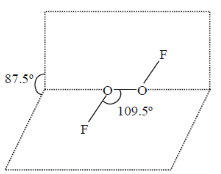
The structure of O2F2 resembles that of H2O2 , in its large dihedral angle, which approaches 90º.
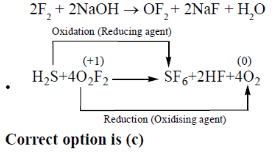
71.The correct set of information is
(a) 
(b) 
(c) 
(d) 
Ans.c
Sol.
In this complex, there is neither orbital contribution nor temperature independent paramagnetism

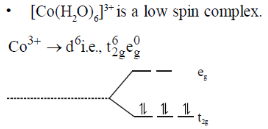
No unpaired electron.
Therefore, it is diamagnetic in nature.
Correct option is (c)
72.Consider the followng statements regarding electronic spectra of high spin complexes
(A)Ti3+ complexes exhibit one sharp band.
(B)Co2+ and Cr3+complexes exhibit two broad bands.
(C)Mn2+ complexes exhibit a series of very weak and sharp bands.
(D)Ni2+ complexes exhibit three broad bands.
The correct statements are
(a) A and C
(b) A, C and D
(c) C and D
(d) B, C and D
Ans.c
Sol.
Ti3+ complex exhibit one broad band due to
(i)Vibronic coupling
(ii)Jahn - Teller distortion
(iii) Spin - orbit coupling

Exhibit three broad bands due to following transitions :

Exhibit three broad bands due to following transitions :

• Mn2+ complex  complex exhibit a series of very weak (spin forbidden, Laporte forbidden and sharp bands).
complex exhibit a series of very weak (spin forbidden, Laporte forbidden and sharp bands).
 exhibit three broad bands due to following transitions :
exhibit three broad bands due to following transitions :

73.Match the appropriate geometry on the right with each of the species on the left
(A)FXeO(OSO2F)(I) Linear
(B)FXeN(SO2F)2(II) Pyramidal
(C)XeO3(III) T-shaped
(D)XeOF2(IV) Bent
(a) A-I, B-I, C-II, D-III
(b) A-I, B-I, C-II, D-IV
(c) A-IV, B-I, C-II, D-III
(d) A-I, B-IV, C-II, D-III
Ans.a
Sol.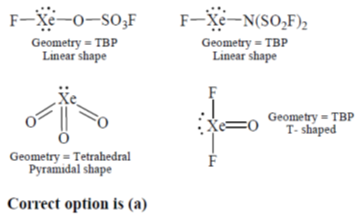
74.Hydrolysis of trans –  results in a product (A). The tendency to form cis-isomer of the product (A) follows the order
results in a product (A). The tendency to form cis-isomer of the product (A) follows the order
(a) 
(b) 
(c) 
(d) 
Ans.b
Sol.
The tendency to form cis-isomer of the product (A) follows the under :
L = NO2– < Cl– < NCS– < OH–
Correct option is (b)
75.Among the following reactions, those that are feasible in liquid NH3 are



(a) I, II and III
(b) I and II only
(c) I and III only
(d) II and III only
Ans.a
Sol.• When aqueous solution of AgNO3 is added to an aqueous solution of KCl, white ppt of AgCl is formed.

But in liquid NH3, the direction of the reaction is reversed.

This reaction is neutralization reaction in liquid NH3
• Ammonia solutions of alkali metals and alkaline earth metals are strong reducing agents.

76.The cations formed upon dissolving SnF4 and AuF3 in liquid BrF3 separately, respectively are
(a) 
(b) 
(c) 
(d) 
Ans.C
Sol.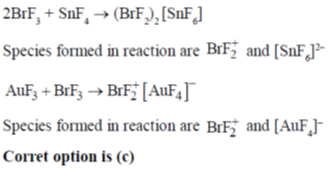
77.Consider the following reactions :


The reaction (s) which will NOT produce ethane as a product is / are
(a) A
(b) B
(c) C
(d) A and C
Ans.c
Sol.

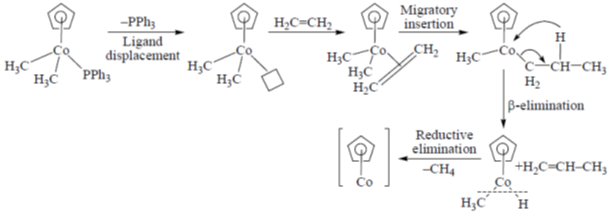
Hence, the reductive elimination product is methane but not the ethane
Correct option is (c)
78.Donor mode of No ligand depends on the metal. Now, consider the following complexes (in gaseous state).
(A) [IrCl(CO)(PPh3)2 (NO)]+
(B) [RuCl(PPh3)2 (NO)2]+
(C) [Co(NCS)(diars)2 (NO)]+, where diars = o – (Me2As)2 C6H4
(D) [Cr(CN)5 (NO)]3–
The complex (es) that do NOT exhibit bent NO coordination mode is / are
(a) A and B
(b) C and D
(c) D only
(d) B only
Ans.c
Sol.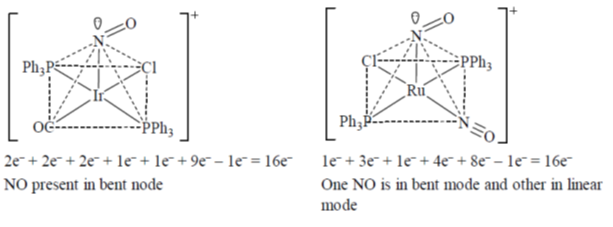
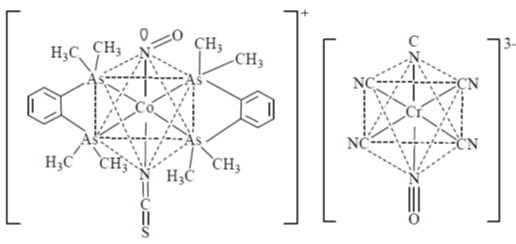

79.An aqueous solution of metal ion (A) gives a blood-red colored product (B) upon reaction with KSCN. Upon dropwise addition of NaF, the complex turns to a colorless compound (C). Identify A, B and C
(a) aq. Fe(II), [Fe(SCN)(H2O)5]+ and [Fe(H2O)6]2+
(b) aq. Fe(III), [Fe(SCN)(H2O)5]2+ and [FeF6]3+
(c) aq. Fe(II), [Fe(SCN)(H2O)5]+ and FeF3
(d) aq. Fe(III), [Fe(SCN)3(H2O)3]+ and FeF3
Ans.b
Sol.An aqueous solution of Fe(III)ion (A) gives a blood-red colour on reaction with KSCN the blood red colour is due to formation of [Fe(SCN) (H2O)]2+ (B). The colour may also used for the identification of Iron (III). This colour is destroyed by the addition of F– ion due to the formation of [FeF6]3– (C).

80.Considering  only, in the MO diagram of a metal complex with trigonal bipyramidal (TBP) geometry, the d-orbitals which remain non-bonding are
only, in the MO diagram of a metal complex with trigonal bipyramidal (TBP) geometry, the d-orbitals which remain non-bonding are
(a) 
(b) 
(c) 
(d) 
Ans.b
Sol.
Two ligands are present on z-axis therefore,  is involved in
is involved in  Also three ligands are present in xy plane, therefore,
Also three ligands are present in xy plane, therefore,  orbitals are involved in
orbitals are involved in  Thus the dyz and dxz orbitals remain non bonding.
Thus the dyz and dxz orbitals remain non bonding.
Correct option is (b)
81.The correct sequence of reactions for the preparation of A is

(a) 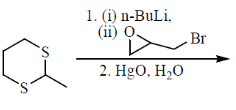
(b) 
(c) 
(d) 
Ans.b
Sol.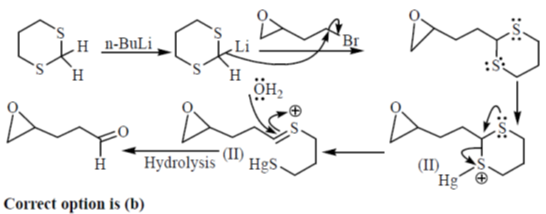
82.Structure of A and B in the following reactions are
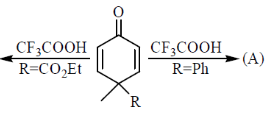
(a) 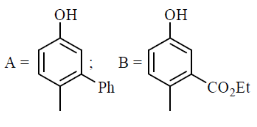
(b) 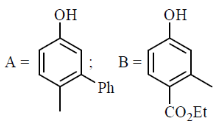
(c) 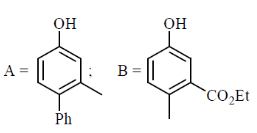
(d) 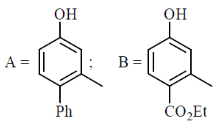
Ans.a
Sol.Dienone-Phenol rearrangement :

Migratotary aptitude Ph > Me.
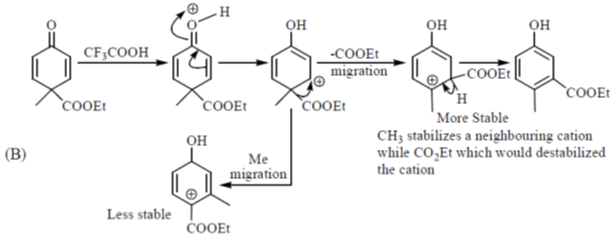
Correct answer is (a)
83.The major product of the following reaction is

(a) 
(b) 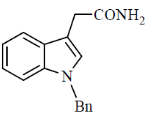
(c) 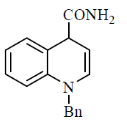
(d) 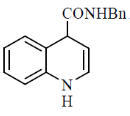
Ans.b
Sol.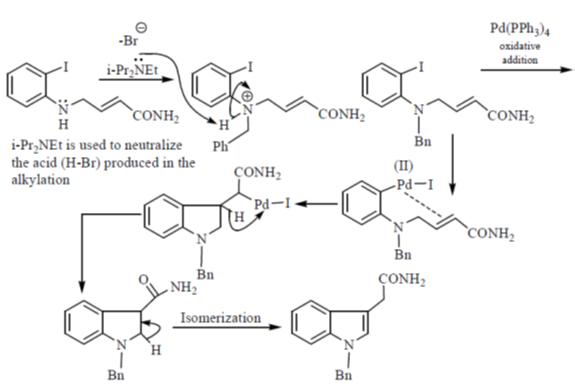
Correct answer is (b)
84.The compound that exhibits the following spectral data is
IR :  1685 cm–1; 1H NMR :
1685 cm–1; 1H NMR :  7.60 (d, J = 8Hz, 2H), 3.65 (t, J = 7 Hz, 2H),
7.60 (d, J = 8Hz, 2H), 3.65 (t, J = 7 Hz, 2H),
3.18 (t, J = 7 Hz, 2H), 2.25 (pentet, J = 7 Hz, 2H) pprm; 13C NMR ;  36, 45, 128, 130, 133, 137, 197 ppm; EI MS m / z : 200, 198 ( 1 : 1), 185, 183 (1 : 1)
36, 45, 128, 130, 133, 137, 197 ppm; EI MS m / z : 200, 198 ( 1 : 1), 185, 183 (1 : 1)
(a) 
(b) 
(c) 
(d) 
Ans.a
Sol.All are ketones C = O structure, 1685 cm–1.
All have one Cl and one Br

• Triplet at 3.65 ppm of 2H indicates –CH2–Cl at terminal
• These two key parameters rersults.
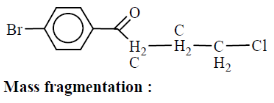


Correct answer is (a)
85.The major product of the following reaction sequence is

(a) 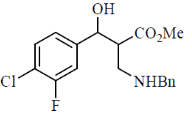
(b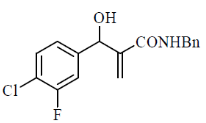
(c) 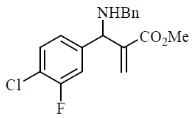
(d) 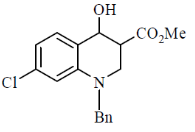
Ans.a
Sol.
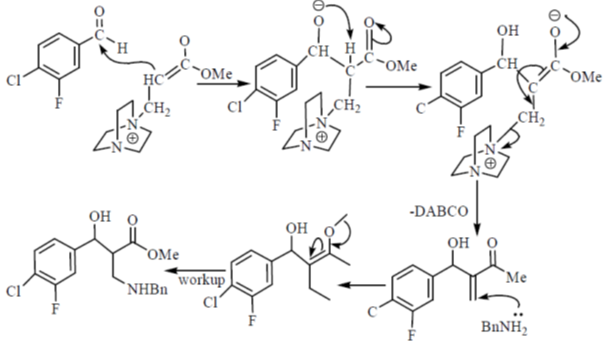
Correct answer is (a)
86.The major products (A) and (B) of the following reaction sequence are

(a) 
(b) 
(c) 
(d) 
Ans.d
Sol.


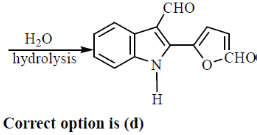
87. The major product of the following reaction is
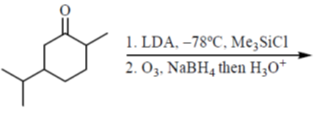
(a) 
(b) 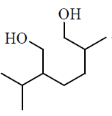
(c) 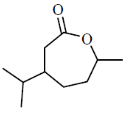
(d) 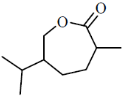
Ans.d
Sol.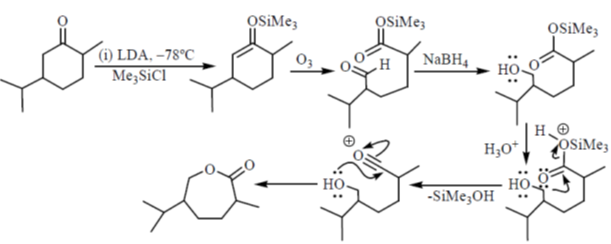
Correct answer is (d)
88.Structures of the products (A) and (B) in the following photo-deprotection reactions are

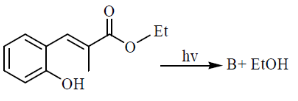
(a) 
(b) 
(c) 
(d) 
Ans.a
Sol.Norrish type-II mechanism for the photocleavage of a 2-nitrobenzyl based photolabile protecting group.
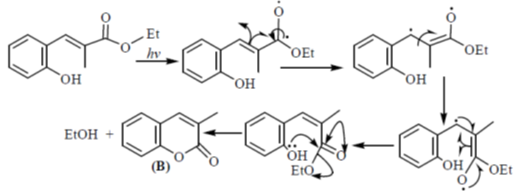
Correct answer is (a)
89.Structure of the monoterpene (A) that undergoes following degradation is
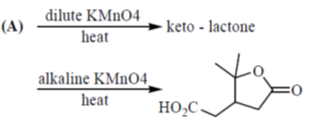
(a) 
(b) 
(c) 
(d) 
Ans.c
Sol.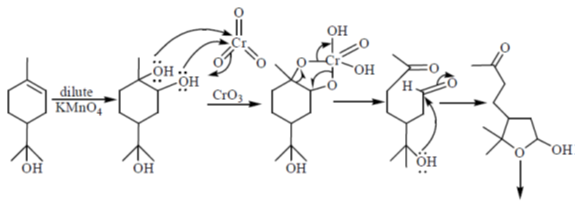
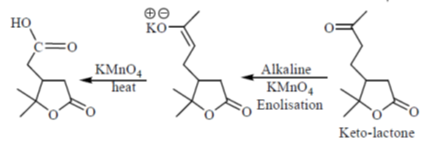
Correct answer is (c)
90.The major products (A) and (B) in the following reaction sequence are

(a) 
(b) 
(c) 
(d) 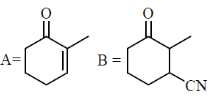
Ans.c
Sol.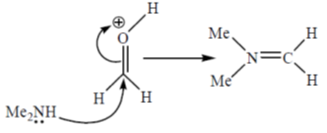
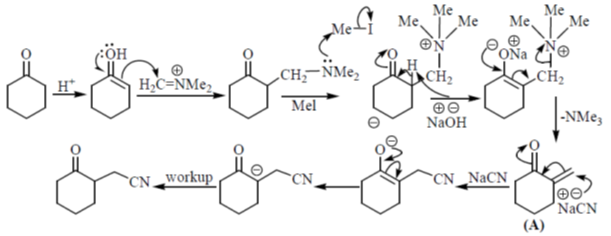
Correct answer is (c)
91.The major products (A) and (B) in the following reaction sequence are

(a) 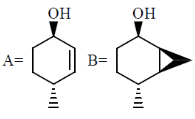
(b) 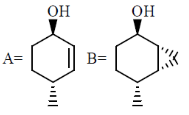
(c) 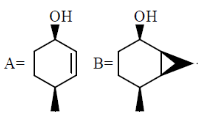
(d) 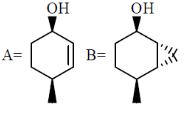
Ans.a
Sol.
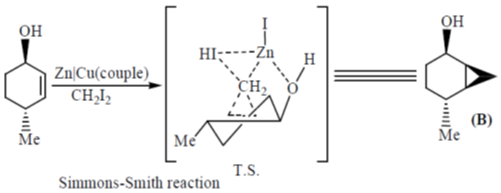
Correct answer is (a)
92.The major product formed in the following reaction is

(a) 
(b) 
(c) 
(d) 
Ans.a
Sol.
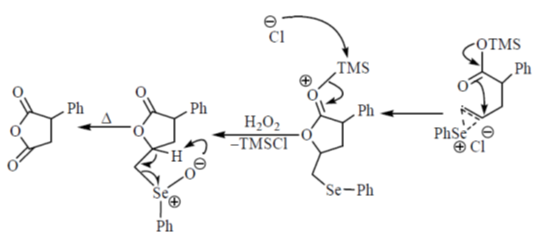
Correct answer is (a)
93.The major products (A) and (B) in the following reactions are

(a) 
(b) 
(c) 
(d) 
Ans.a
Sol.

Correct answer is (a)
94.The major product formed in the following reaction is
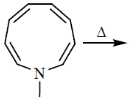
(a) 
(b) 
(c) 
(d) 
Ans.a
Sol.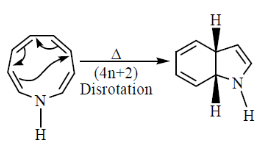
Correct answer is (a)
95.The major product formed in the following reaction is
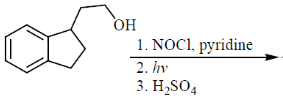
(a) 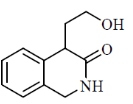
(b) 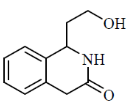
(c) 
(d) 
Ans.b
Sol.
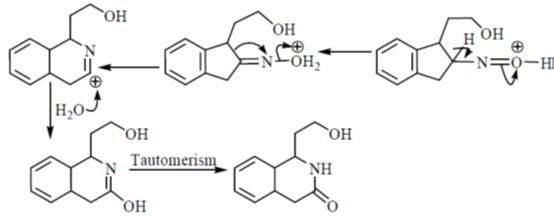
Correct answer is (b)
96.The major products (A) and (B) formed in the following reaction sequence are

(a) 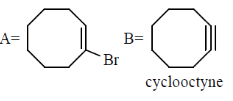
(b) 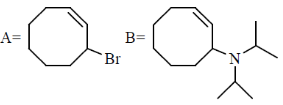
(c) 
(d) 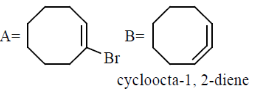
Ans.a
Sol.
Correct answer is (a)
97.The major product formed in the following reaction is

(a) 
(b) 
(c) 
(d) 
Ans.c
Sol.
Correct answer is (c)
98.Ths structure of product (B) formed in the following reaction sequence is

(a) 
(b) 
(c) 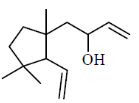
(d) 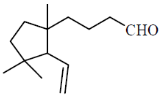
Ans.
Sol.
99.The major products (A) and (B) in the following reaction sequence are

(a) 
(b) 
(c) 
(d) 
Ans.d
Sol.Benzoin condensation followed by Benzil Benzylic acid re-arrangement :
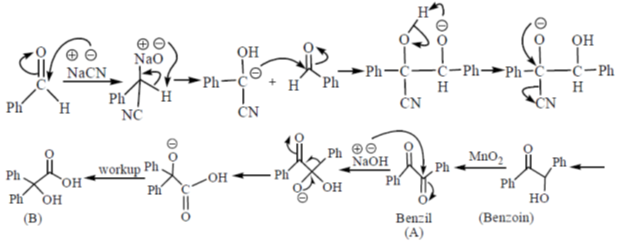
Correct answer is (d)
100.Reaction of styrene (PhCH=CH2) with HBr gives a mixture of regioisomers A (major) and B (minor). the 1H NMR spectrum of the mixture shows four signals, amongst others, at  3.53, 3.15 and 2.00 ppm with relative integration of 2 : 1 : 1 : 6, respectively. The molar ratio of A and B is
3.53, 3.15 and 2.00 ppm with relative integration of 2 : 1 : 1 : 6, respectively. The molar ratio of A and B is
(a) 3 : 2
(b) 4 : 1
(c) 2 : 1
(d) 3 : 1
Ans.b
Sol.
For the obtained mixture, the relative integration ratio given is
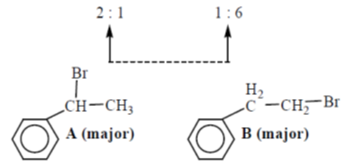
To obtain the given intensity ratio, the mole ratio of A and B should be 4 : 1.

Correct answer is (b)
101.The energy functional from a trial wave function is

The variationally optimized energy is
(a) 
(b) 
(c) 
(d) 
Ans.b
Sol.
For variationally optimized energy, 
The variationally optimized energy will be

Correct answer is (b)
102.A satisfactory spin wave function for an excited helium atom is
(a) 
(b) 
(c) 
(d) 
Ans.a
Sol.
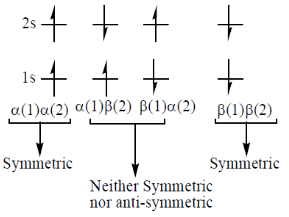

103.For a linear molecule the mean energies for translation, rotation  and vibration
and vibration  follow ratio :
follow ratio :
(a) 
(b) 
(c) 
(d) 
Ans.b
Sol.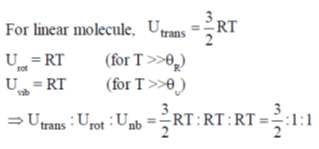
Correct answer is (b)
104.The highest energy π-molecular orbital for the allyl system is
(a) 
(b) 
(c) 
(d) 
Ans.c
Sol.
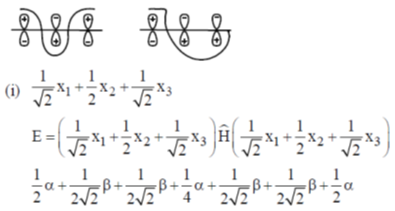




Correct answer is (c)
105.An unnormalized wave function of the hydrogen atom is given by  The three quantum numbers,
The three quantum numbers,  associated with this orbital are, respectively.
associated with this orbital are, respectively.
(a) 2, 2, 0
(b) 2, 1, 1
(c) 3, 2, 0
(d) 3, 1, 1,
Ans.
Sol.
106.The  of cis-butadiene belongs to the irreducible representation
of cis-butadiene belongs to the irreducible representation
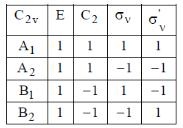
(a) A1
(b) A2
(c) B1
(d) B2
Ans.b
Sol.The character table for C2v point group is given as

The  representation for cis-butadiene
representation for cis-butadiene

The correct irreducible representation corresponding to above  for cis-butadine is
for cis-butadine is

Correct answer is (b)
107.The number of times the A1 representation appears in the representation  of the
of the  group given below is
group given below is

(a) 1
(b) 2
(c) 3
(d) 4
Ans.b
Sol.The representation  for the C2v point group is as
for the C2v point group is as

The number of irreducible, 

Correct answer is (b)
108.The populations of proton spins in the highest energy level of a sample in magnetic fields of 1.5T and 7.0T are N' and N, respectively. The value of  are gyromagnetic ratio of the proton, Planck's constant, Boltzmann constant and temperature of the sample, respectively; assume that the partition functions for both systems can be approximated as 1)
are gyromagnetic ratio of the proton, Planck's constant, Boltzmann constant and temperature of the sample, respectively; assume that the partition functions for both systems can be approximated as 1)
(a) 
(b) 
(c) 
(d) 
Ans.a
Sol.Total number of population in excited state is 
Total number of population in ground state is 
Partition function q = 1 in both the cases.
The population ratio 
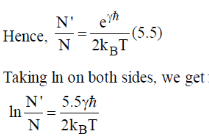
[But in answer 1/2 part is absent, which is obtained from  value. M1 values for protons are +½ and –½]
value. M1 values for protons are +½ and –½]
Correct option is (a)
109.The difference between standard molar entropies of two mono-atomic gases (A) and (B)  at a given temperature is (given that the molar mass of (A) is twice the molar mass of (B))
at a given temperature is (given that the molar mass of (A) is twice the molar mass of (B))
(a) 
(b) 
(c) 
(d) 
Ans.a
Sol.From Sackur Tetrode Equation the molar entropy for monoatomic gas A is

The molar entropy for monoatomic gas B is

The difference between two standard molar entropy is

Correct answer is (a)
110.A non-ideal gas follows the equation,  where B is a function of temperature only. The deviation in internal energy from that of an ideal gas, U – Uideal , is given by
where B is a function of temperature only. The deviation in internal energy from that of an ideal gas, U – Uideal , is given by
(a) 
(b) 
(c) 
(d) 
Ans.b
Sol.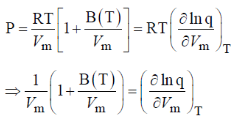
Variable sepration and integration,
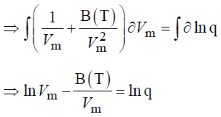
On differentiate with respect to temperature at constant volume
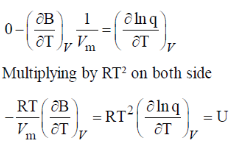
Similarly, if 
On differentiate with respect to temperature at constant volume and multiply by RT2


Correct answer is (b)
111.The gas phase decomposition of A at 1000K follows two decomposition paths

The maximum theoretical percentage yield of P at 1000K is
(a) 62.5
(b) 60
(c) 166
(d) 37.5
Ans.a
Sol.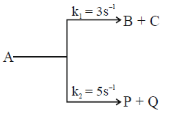
Percentage yield of 
Correct answer is (a)
112.Photochemistry of a molecule, M, is described as by the mechanism
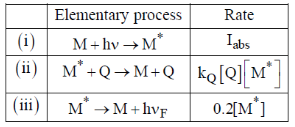
The intercept at [Q] = 0 is 4 for the inverse of fluorescence intensity (I / IF) vs [Q] plot. The value of Iabs is
(a) 4
(b) 0.25
(c) 20
(d) 0.8
Ans.b
Sol.Fluorescence intensity or rate = 0.2 [M*]
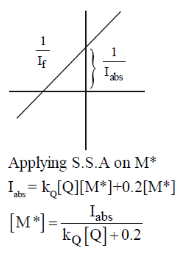
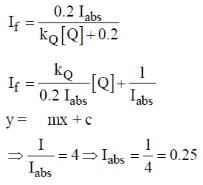
Correct answer is (b)
113.Above the critical micelle concentration (CMC), the option which correctly describes the variation of molar conductivity with increase in concentration of sodium dodecylsulphate in aqueous solution is
(a) Molar conductivity increases sharply, but the solution does not remain colloidal
(b) Molar conductivity decreases sharply, but the solution remains colloidal
(c) Molar conductivity decreases sharply and dissociation into monomers also occurs sharply
(d) Molar conductivity increases sharply with large loss of entropy
Ans.b
Sol.The above critical Micelle concentration, the aggregation of molecules takes place to form Micelle resulting in the drastic decrease in molar conductivity. The size of aggregation is still in colloidal range.
Correct answer is (b)
114.When two moles of liquid A are mixed with two moles of liquid B at 300K, the excess molar Gibbs energy of the solution is –1.5 kJ mol–1. The corresponding value of Gibbs energy of mixing (in kJ) is closest to (R = 8.3 J K–1 mol–1)
(a) –12.9
(b) –6.0
(c) –1.5
(d) –0.9
Ans.a
Sol.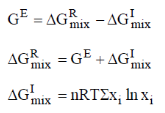
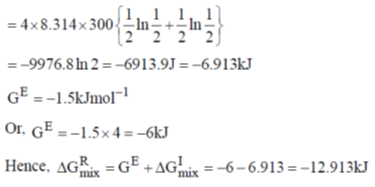
Correct answer is (a)
115.A sample of 2.0 moles of O2(g) (assumed ideal) at 500K is expanded from 5L to 50L under adiabatic and reversible conditions. The change in its internal energy (in kJ) is close to 
(a) –22.5
(b) –12.5
(c) –19.1
(d) –7.5
Ans.b
Sol.For adiabatic process, 


Correct answer is (b)
116.The reaction rate of self-catalyzed polyesterification reaction is given as

If [M]0 is the initial concentration of hydroxyl and carboxyl monomers, then the degree of polymerization,  is given by
is given by
(a) 
(b) 
(c) 
(d) 
Ans.c
Sol.For IIIrd order reaction, 
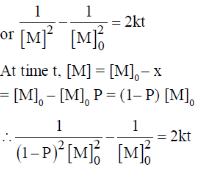
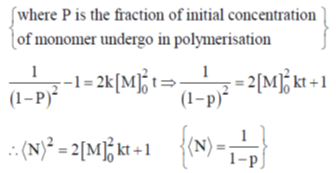
Correct answer is (c)
117.The correct relationship among the following, for a tetragonal  crystal system, is
crystal system, is
(a) 
(b) 
(c) 
(d) 
Ans.c
Sol.From Bragg's equation, 

On squaring both sides, we get

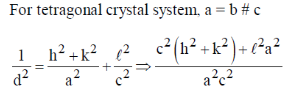
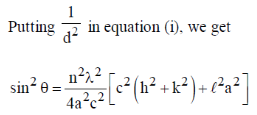
Correct answer is (c)
118.If the overpotential of an electrolysis process is increased from 0.5 V to 0.6 V, then the ratio of current densities  of the electrolysis will be equal to (given transfer co-efficient = 0.5)
of the electrolysis will be equal to (given transfer co-efficient = 0.5)
(a) 
(b) 
(c) 
(d) 
Ans.b
Sol.According to Tafel equation,
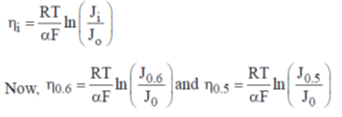

Correct answer is (b)
119.The chemical potential  of 2 molar Na2SO4 solution is expressed in terms of mean ionic activity co-efficient
of 2 molar Na2SO4 solution is expressed in terms of mean ionic activity co-efficient 
(a) 
(b) 
(c) 
(d) 
Ans.a
Sol.
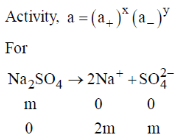



Correct answer is (a)
120.The Birge-Sponer plot between  slope of –14 cm–1 and intercept of 2170 cm–1 . The approximate value of dissociation energy of CO (in cm–1) is (Assume CO as an anharmonic oscillater with the energy expression)
slope of –14 cm–1 and intercept of 2170 cm–1 . The approximate value of dissociation energy of CO (in cm–1) is (Assume CO as an anharmonic oscillater with the energy expression)

(a) 42044
(b) 84088
(c) 168175
(d) 3363350
Ans.c
Sol.

Given slope  and intercept 2170 cm–1
and intercept 2170 cm–1
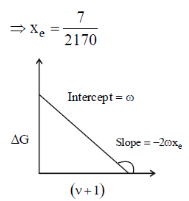
Therefore, dissociation energy (approx)

Correct answer is (c)
